Authentic, naked, and raw, this city exposes itself with all of its colors. It is so monumental as it is decadent. Neat and chaotic, all at once. With an exuberant bustle and an engaging personality, it conquers you immediately. Maybe it’s the centuries of art and architecture. Maybe it’s the best pizza in the world. Even if you visited many cities in Italy, you will be surprised by Naples!
Located on the Gulf of Naples in the Tyrrhenian Sea, Naples has more than two millennia of history and over the centuries it has been an important port city and the main industrial and commercial center of southern Italy. Its historic center has been declared a UNESCO World Heritage Site, but it is also a tourist attraction due to the surrounding sites of interest, especially the (still active) volcano of Mount Vesuvius and the ruins of Pompeii.
Come with us and discover the charms and authenticity of Naples!
Explore the Centro Storico and the Quartieri Spagnolli
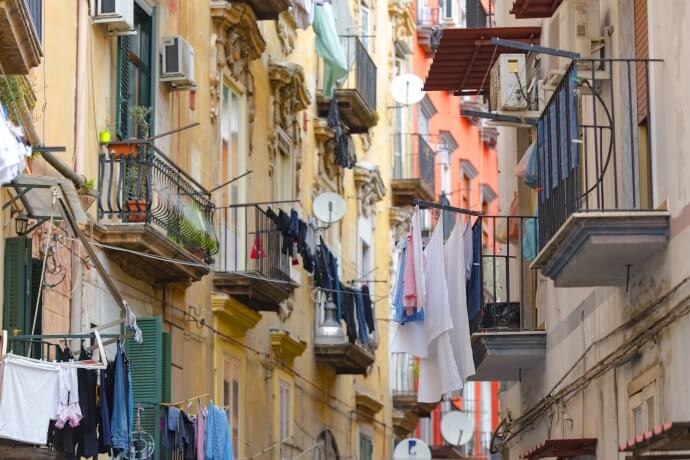
The streets are the best awakening of the senses. Colors, odors, and flavors emerge in an immediate and inescapable amalgam. Ruined and dirty buildings with graffiti walls coexist with some of the most beautiful monuments in Italy. The Centro Storico or Old Town of Naples is the oldest part of the city and is where the Neapolitan soul lives, with kind and friendly people, proud and hospitable, frontal without half-words. If you are looking for the genuine Naples go for the street Spaccanapoli (literally "smash-Naples"), which divides the Centro Storico and runs from the Quartieri Spagnoli to the neighborhood of Forcella.
The Quartieri Spagnoli has a very peculiar soul and charisma. The streets are narrow and busy; people have the doors and windows of their houses open and use the street as an extension of their own dwellings. They are affable and hospitable, and proudly Neapolitan!
Here you may admire the street art of Naples, knowing the city is an immense canvas where the creativity of the Neapolitans has no limits. What may seem like vandalism is actually a message!
Feel the heart of Naples in the Plebiscite Square and the Royal Palace
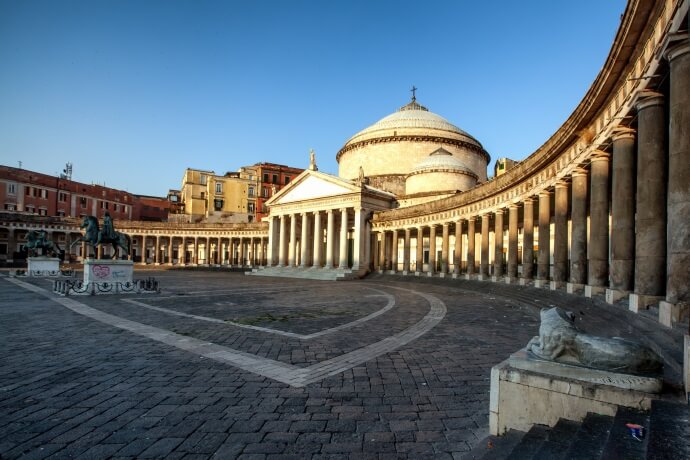
The neoclassical Plebiscite Square is the heart of Naples. With amazing dimensions, is one of the largest squares in Italy, one of the most emblematic in Europe, and a symbol of the city. A stage for cultural events with a monumentality difficult to match. In the square itself and in the adjacent streets are some of the city’s most impressive monuments. Standing in the center, you are in front of four significant monuments of Neapolitan history: the Basilica of San Francesco di Paola, the Royal Palace, the Salerno Palace, and the City Hall of Naples.
The Royal Palace of Naples, also known as the Palazzo Reale, was constructed during the 17th century and has served as the hub of authority in southern Italy for over three hundred years. Today, it stands as a prominent entrance to the city of Naples and overlooks the sea. The awe-inspiring structure encompasses a sequence of porticos, courtyards, and gardens, all leading to the spaces that were once the residence of the Royal Palace's court. The highlight of the Palace is undoubtedly the historic apartments, which house an array of antique treasures, like paintings, furniture, marble stucco, and tapestries that narrate the story of the Palace's previous residents.
The Neapolitans are very superstitious and Plebiscite Square is the scene of a belief. Legend says that the one who goes from the Royal Palace to the other end of the square, passing between the two equestrian statues, will have a life filled with luck. But must do it blindfolded!
Watch an opera in Teatro di San Carlo
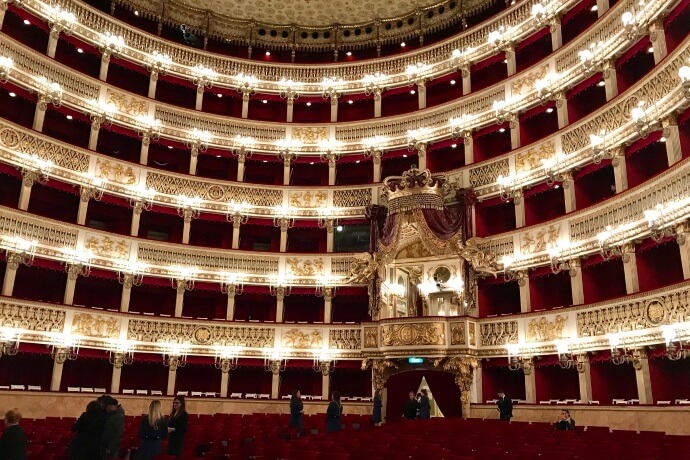
Next to Plebiscite Square stands the Italian opera temple. Anticipating the Scala in Milan by 41 years, the Teatro di San Carlo is the oldest European theatre still operating. Built in 1737, by the will of King Charles III of Bourbon, it was supposed to show the royal power of the monarchy.
After several works of maintenance and restoration due to a fire, it was re-inaugurated in 1817. The French writer Stendhal, one of the many European personalities that attended the event, wrote: “The first impression is that of having fallen into the palace of an oriental emperor. The eyes are dazzled, the soul enraptured..."
If you also want to be amazed, go watch an opera and admire the architecture, the acoustics, and the incredible conservation of this true work of art.
Visit the Duomo and learn about the legend of San Gennaro
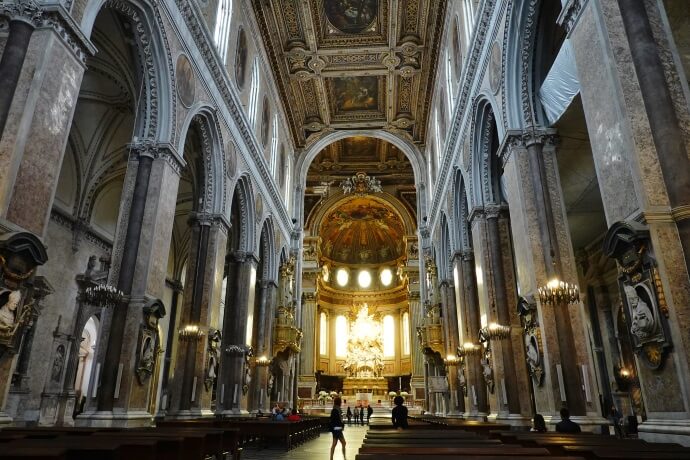
The bustling Centro Storico houses numerous ornate churches, most notably the Duomo di San Gennaro or the Cathedral of Naples, shining since 1313 as one of the most sublime Gothic temples in Italy. It houses the old baptistery and beautiful altars, especially the chancel decorated with spectacular frescoes. In the smaller side chapels you will find the most beautiful spaces.
It is necessary to know San Gennaro to understand Naples and the way the Neapolitans live their devotion to the patron saint of the city. When you see the Treasure of San Gennaro, relics, and silver statue of the saint, you will have a clear perception of the fervent adoration of Naples to its patron saint. This is one of the most important religious buildings in the city and is truly impressive. Even if you don’t believe in the "miracle of San Gennaro"!
Every year, families, monks, priests, and nuns come from all over Italy and various countries to witness the miracle of San Gennaro - what is believed to be the blood of Saint Gennaro liquefying inside two ampoules in front of their very eyes. Being the protector of the city of Naples, locals look forward to the blood liquefaction because it is their belief that prevents diseases, wars, famine, and eruptions of Mount Vesuvius! This religious event happens at least three times a year: Festa di San Gennaro on September 19; the first Saturday of May; and the anniversary of the 1631 eruption of Mount Vesuvius on December 16.
Head underground
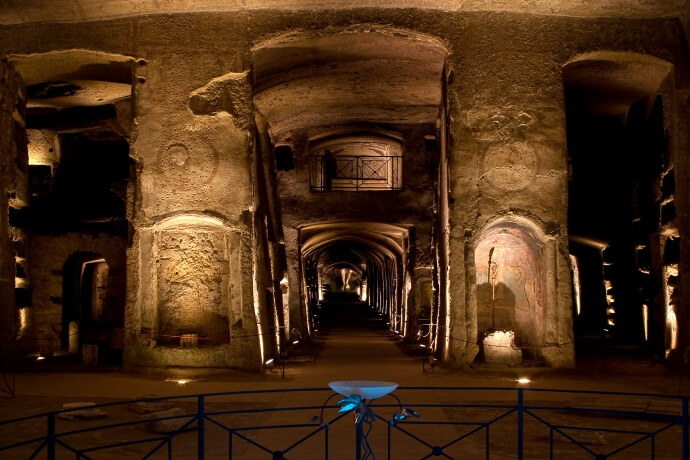
Deep beneath the bustling streets of Naples lies an Underground Naples that's been around for over 2000 years! That's right, this city has been permanently inhabited for so long that even the dirt below your feet has stories to tell. Close to the cathedral of Naples is the entrance to the Napoli Soterranea, an incredible experience - except for claustrophobic ones! These underground tunnels have been used for everything from storing Roman cisterns to hiding from bombs during World War II. And that's not even the best part - you'll also get to see the Hypogeum Gardens, the War Museum, a Greco-Roman aqueduct, and the ruins of the Roman Theater of Neapolis!
In the Rione Sanità district, you will find a symbol of the city's fascination with the afterlife in the Catacombe di San Gennaro. It became a pilgrimage site since San Gennaro was buried there in the 5th century and carefully restored to allow visitors. This extensive burial site holds many treasures including 2nd-century Christian frescoes and 5th-century mosaics.
If you're looking for something a bit more recent, check out the Galleria Borbonica - a museum built into 200-year-old tunnels that were sealed up back in the '50s – but "rediscovered" in 2015!
Admire the Sansevero Chapel
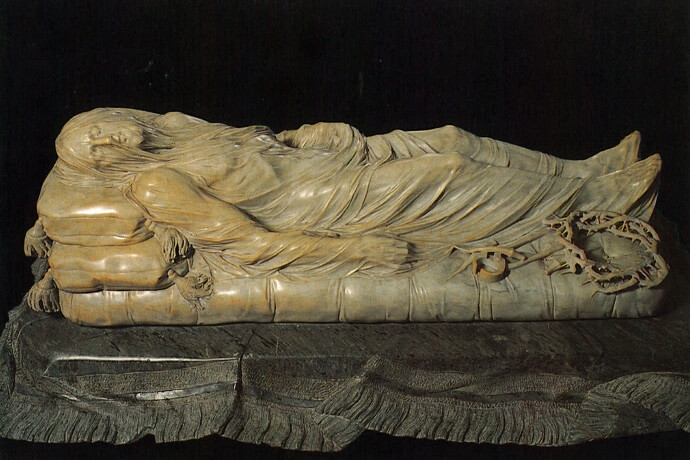
Located in the city center, the Capella Sansevero is a beautiful Neapolitan Baroque family chapel and museum in honor of the Princes of San Severo. Legend says its origin dates to 1590, when a man wrongly imprisoned saw an image of the Madonna and then build a shrine there. The Duke of Torremaggiore later prayed to the Madonna for recovery from a serious illness and as it was cured, built a chapel in place of the shrine. In the early 17th century, the Duke's son enlarged the chapel to create a family mausoleum, and it has remained largely unchanged since then.
Mystical and enigmatic, the Sansevero Chapel holds some of the most amazing marble statues in the world, each one more beautiful than the other. The chapel is centered around an impressive marble sculpture of the Veiled Christ. Dating from the 18th century, it is an artwork by Giuseppe Sanmartino and is truly incredible. It depicts Jesus Christ lying and wrapped in a veil so well carved that it appears to be transparent, even though the whole statue is made of marble. The effect is extraordinary!
Learn how to cook Neapolitan Pizza

Aaaahhh, pizza! Our companion on weekend nights, our savior for when hits that laziness of cooking... Pizza is present all over the world but did you know any average pizzeria in Naples serves better pizzas than anywhere else? Because in 1982, the Association of the True Neapolitan Pizza, (Associazione Verace Pizza Napoletana) was created to promote authentic Neapolitan pizza! The pizza is now recognized as a DOC product (Di Origine Controllata) which attests that the products are made with regional produce and follow certain rules, such as being worked only with the hands. And the ingredients? Well, do not ask for pineapple or ketchup or Neapolitans might kick you out of town!
No historian has resolved yet the origin of pizza. Some say it originated in Egypt, others swear it came from Greece. Between comings and goings, it reached the so-called "cradle of pizza", Naples! The oldest pizzeria in Italy opened in Naples in 1738, it’s called Port'Alba and still works today!
Pizza was something only the poorest people would eat until 1889, when the pizzaiolo Dom Raffaele Espósito served a pizza to Queen Margherita di Savoia, using cheese, tomato, and basil as the colors white, red, and green of the Italian flag. The Queen love it that is how Pizza Margherita was created! Since then, all social classes would it pizza.
In Naples, being a pizzaiolo (a person that makes pizza) is not just a job, it's an art form. And the pizza is a masterpiece crafted with love, dedication, and true appreciation. So, to unravel Naples’s true soul, you must learn how to cook Neapolitan pizza! It’s a way to gain insight into the city's rich culinary traditions and understand why the locals are so passionate about the art of pizza-making.
Visit Santa Chiara Monumental Complex
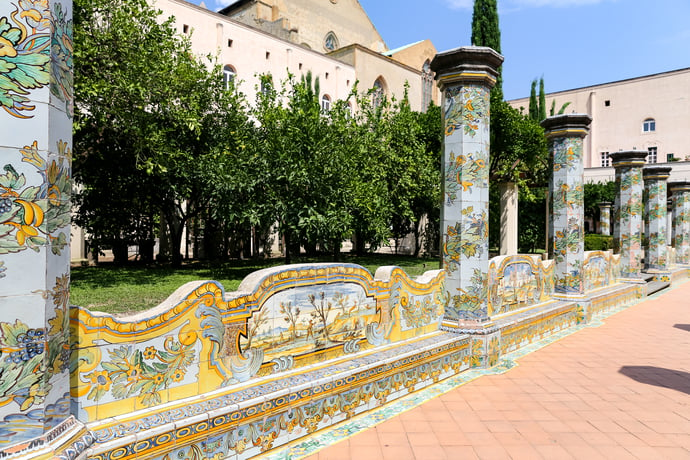
The Santa Chiara Monumental Complex was built between 1310 and 1328, on top of the ruins of a Roman Spa, by the will of King Robert D'Angiò. It is a religious complex currently formed by a basilica, a double monastery, a crypt, and an archaeological museum. Located in the heart of the historic center, it is one of the main attractions of Naples - at least for lovers of frescoes and tiles! And who isn’t?
The cloisters and the interior garden, with tiles in Italian maiolica, are stunning. There are dozens of octagonal columns covered with hand-painted tiles; and benches decorated with tile panels, in shades of blue and yellow, which connect each of the pillars. The visual effect is fascinating!
Explore the shopping scene
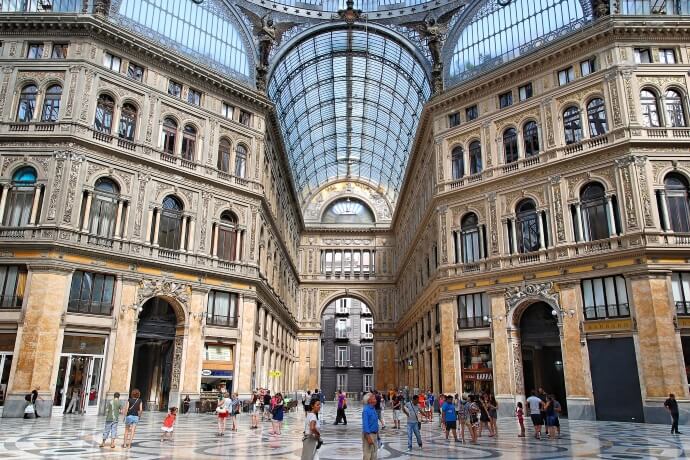
Corso Umberto is a wide avenue with large shopping franchises and is one of the most frequented in Naples. However, if you are looking for authentic Neapolitan shopping, look no further. In the busy Quartieri Spagnoli we find a grid of narrow streets, flanked by the unmissable Via Toledo. This partially pedestrian street is full of typical trattorias and fashion shops. In the middle of it is the Galleria Umberto I. Designed in the late 19th century as part of the city’s renaissance after Italian unification, it resembles the Galleria Vittorio Emanuele II in Milan, and its impressive glass dome and floors really catch the eye! Nowadays, it is more of a tourist attraction than a shopping gallery used by the Neapolitans.
If you like Christmas decorations, you must visit Via San Gregorio Armeno. Small and pleasant, it is one of the best-known shopping streets in the city, and its stores are specialized in images and decorative objects of the Nativity.
Throughout Naples, there are stalls selling a wide variety of products where you can taste local specialties and buy typical products. The best are in Via Pignasecca, Via Chiaia and Via Benedetto Croce. It may be for the shopping, but it is also a real pleasure to stroll through these small streets in the heart of Naples and be carried away by the magical atmosphere.
Walk along Lungomare Caracciolo
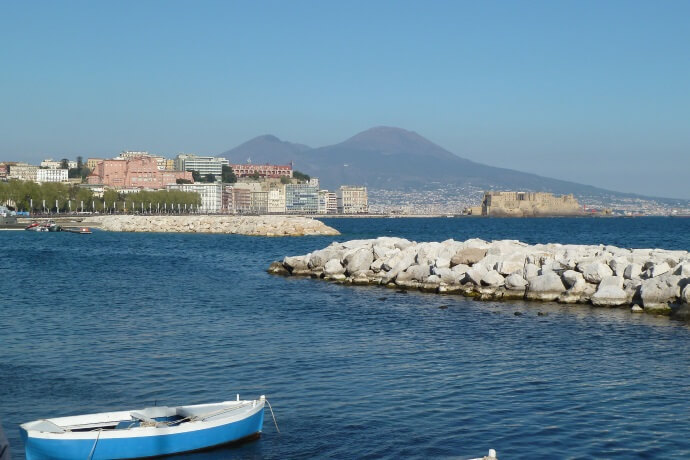
In the charming Chiaia neighborhood, the Lungomare Caracciolo is a seaside promenade that is a must-see when visiting Naples. This elegant esplanade boasts stunning views of the bay and Vesuvius, along with plenty of charming cafes and ice cream parlors where you can sit back, relax, and soak up the vibrant atmosphere. As you stroll along the Lungomare Caracciolo, you'll quickly understand why the port of Naples has been a gateway to the Mediterranean and the world for centuries. This bustling hub of activity truly embodies the spirit and energy of this vibrant city.
At one end of the Lungomare Caracciolo, you'll come across the mysterious Castel del'Ovo, literally meaning "Egg Castle". Legend has it that a mage hid a magical egg in its foundations during the Middle Ages, in order to protect the castle and the city. It's a fascinating piece of history that's just waiting to be explored!
And if you're looking for breathtaking views, be sure to head to the Belvedere of the Chiesa di Sant'Antonio a Posillipo. Located at the opposite end of the Castel del'Ovo, this viewpoint offers some of the most beautiful panoramic views over the Gulf of Naples. It's truly a sight to behold!
Indulge in the street food (Warning, you may salivate reading this!)
.jpg?width=690&height=460&name=Indulge%20in%20the%20street%20food%20(Warning%2c%20you%20may%20salivate%20reading%20this!).jpg)
In Naples, everyone lives on the street. And they eat on the street too! That is why Naples has one of the best street food scenes in Europe. It is a land of temptations that will make your taste buds clap their hands with excitement!
Two things characterize Neapolitan street food: there are some variants of pizza and lots of fried food! And one of the best is Pizza Fritta. While the name means deep-fried pizza, this super popular food looks more like a deep-fried calzone. You can find Pizza Fritta in every pizzeria, kiosk and “friggitorie“ – places that only cook deep-fried Neapolitan food. Other variants of pizza are: Pizza Portafoglio, which is a folded pizza Margherita; Cono Pizza, a mix between pizza and an ice-cream cone with the inside filled with mouthwatering toppings and lots of sauce; and Pizza Montanara, possibly the best for a good overview on the local flavors. It is puffy, soft, and… deep-fried!
The Panzerotti, also known as Crocchè in Italian, indicates yummy potato bites, covered in bread crumbs and deep fried. Usually, Neapolitans ask for a bag of Pezzelle e Panzerotti (or Pasta Crisciuta and Crocché). Pasta Crisciuta, also known in the Neapolitan dialect as Zeppole or Pezzelle, is one of the most loved, easy-and-yummy street foods. And, they’re deep-fried, like most of the street food in Naples!
Taralli is one of the street foods that Neapolitans love to snack on while drinking a cold beer. Their favorite place to do it is in Lungomare Caracciolo, watching the ships go by and admiring the city lights at night. Traditional Taralli is made of lard, ground pepper, flour, and almonds.
Other must-tries are Fiori di Zucca Ripieni which are crunchy, deep-fried pumpkin flowers with a filling; Neapolitan Cuoppi, that basically is a paper cone filled with yummy goodies; Frittatina, with a crunchy outside hiding a creamy interior that you only find in Naples; and Cuzzetiello con Polpette e Ragù that is basically a bread bowl filled with ragu sauce and Neapolitan meatballs, fried, and then cooked a second time in the tomato sauce. (We warned you about the salivation!)
%202.jpg?width=690&height=460&name=Indulge%20in%20the%20street%20food%20(Warning%2c%20you%20may%20salivate%20reading%20this!)%202.jpg)
Make sure you save some room for dessert because the delicious Neapolitan treats can satisfy your craving for something sweet. Sfogliatella is the symbol of Naples just as much as pizza. Only here you’ll have the chance to eat authentic handmade ones, and there are two types: the Sfogliatella Riccia and the Sfogliatella Frolla. You will recognize its sweet and buttery scent whenever you walk into an area where a “pasticceria” is baking Sfogliatelle.
With its unmistakable mushroom shape, the Neapolitan Babà is a very popular cake, which you can eat on the go, as a sweet treat after lunch, or as an afternoon snack. But be careful, because this cake is soaked in a mix of rum, water, and sugar. Usually, when you buy it, they even add some more, because half the fun is basically eating it without messing up your clothes!
Detour to Pompeii
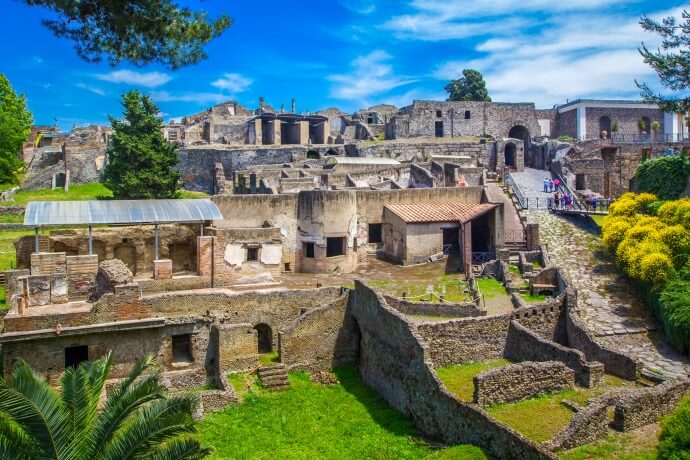
Just half an hour from Naples is the legendary city of Pompeii. This ancient Roman metropolis was buried by a volcanic eruption back in 79 AD, and it's now a UNESCO World Heritage Site. Get ready for an emotional journey as you stroll through the streets frozen in time for nearly two thousand years. From hot springs to erotic art (yes, you read that right), this place has got it all!
If you are feeling brave, climb to the summit of the crater of Mount Vesuvius. Yes, it is an active volcano, but you'll be rewarded with some breathtaking views of the Gulf of Naples. Just hope it doesn’t wake up while you're there!
Also a must-see is Herculaneum, another Roman city buried by the same eruption that buried Pompeii. Pro tip: trying to see both Herculaneum and Pompeii in one day is a recipe for exhaustion.
Will you fall in love with Naples?
If there is a word to define Naples, it must be Passion! Neapolitans are passionate people, impulsive and authentic, and little concerned with appearances. And this reflects in the city! Beautifully decadent, it is filled with graffiti, decrepit palaces, and imposing cathedrals. It is a blend of chaotic streets, delicious food, and joyous people, talking loudly and living with their doors open. Naples shows itself without makeup or Instagram filters. It is what it is. And we love it!



